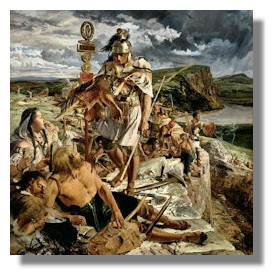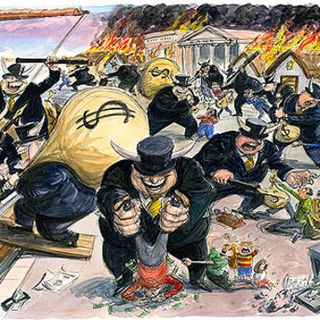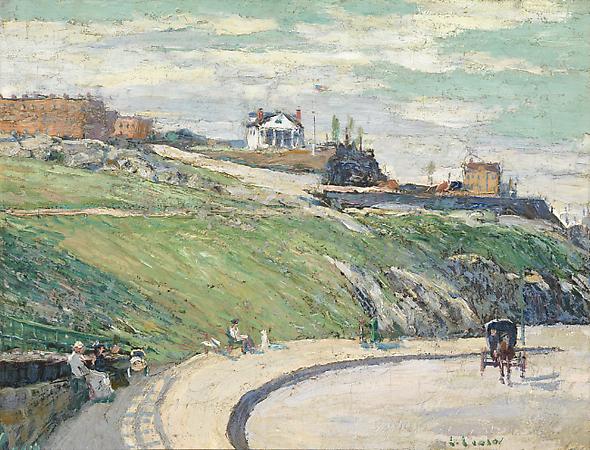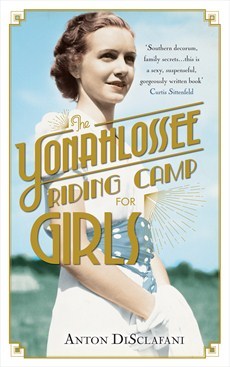We spent most of the weekend reviewing and revising and editing the latest printout of
The American Slave Coast (which we'll be doing for many more months, one revision after another, each time the various themes more focused and clear, hopefully). Among the variety of discussions we had was this one: What were the most important changes and effects upon the former North American Atlantic colonies as a consequence of Independence from Britain? How much emphasis should we give those in
The American Slave Coast as our primary focus is the slave economy of the American South? Some need more emphasis than others, since aspects that created the slave economy would only have happened with Independence -- and those in turn created huge strands of American culture in general, particularly music.
Separation of Church and State:
The most significant change was the disestablishment of the Anglican church, the separation of church and state, making for religious tolerance as the law of the land. Disestablishment affected the North and South in different ways.
In the South it closed the Church as a path to political power and riches. In the South younger sons needed to become lawyers and / or slave dealers / breeders, as the quickest way to wealth and significance. In New England there were colleges, a proliferation of schools, and professional enterprises beyond the law. In the North, as a non-slave trade based economy, there were mercantile, banking and shipping opportunities they lost no time in taking advantage of, not the least returning to the West Indies carrying trade to and from, with particular attention given to bringing back rum to slake the bottomless thirst of both the North and South. Too bad Jefferson screwed the pooch on that one, all over again, with his hated embargo, which brought all trade to an end, and had New England screaming to secede, and sent the newly solvent U.S.'s economy into full depression.
In the North, Methodists and Baptists and many others were no longer repressed by Quakers (in Pennsylvania), the Puritans' Congregationalists in New England, and Presbyterians and Anglicans in South Carolina and Virginia. Maryland was officially tolerant before the War of Independence, with the ruling elite generally Catholic, but before Independence Maryland still had to support Anglican bishops, priests, etc. Church attendance was mandatory for everyone who wasn't excused by membership in another faith's congregation. Obviously this could not be enforced outside the small settled coastal enclaves. Already, before Independence, beyond the pale it was a lawless free-for-all, particularly as the 'west' attracted the very poor Scots-Irish imigrants and run-away indentures, as well as run-away slaves (slaves particularly ran to the Floridas, which under Spanish rule and non-slave, provided a haven of maronage). After disestablishment church attendence and membership soon stopped being mandatory.
Needless to say mandatory church membership and attendence did not apply to the enslaved, but long before Independence, the African American communities were enthusiastic attendees of Sunday church, both in white folks' churches and in their own services. Baptist and Methodist forms, and the Awakening's evangelical passions, provided African Americans a more traditional way into religious joy, with call and response preaching, singing, dancing aiding them to transcend their bleak daily existence and merge with the other world. Their traditional spiritual practices were unacceptable to whites, but this was allowed. (Still no drums though.)
In Virginia both the enslaved and free African Americans soon became Protestant, spoke English and had merged their various African folkways with those of their English owners for at least three generations before Independence (you find 'fetish' bundles secreted inside the sophisticated architecture of houses build in 18th century Annapolis, built by slaves who'd been sent to England for training in architecture, carpentry, cabinetry and other valuable building skills -- slaves who were Christian). They were gifted players of the fiddle (and the violin if their owners so pleased). Drums were strictly forbidden them, but they were allowed wind instruments. The Maryland and Virginian aristocrats were fox hunters already in the early 18th century -- the houndsmen who blew the horn signals were their slaves. It was the same in Maryland, except that with its tolerance, Methodist and Baptist pastors had already converted large numbers of the both the enslaved and free African Americans. But it wasn't until a few years after Independence that African Americans were able to build their own first AME churches, at about about the same time in Philadelphia and Baltimore.
It's out of these churches we get the musical traditions, much later labeled Gospel, that fed directly into what even later would be rock 'n roll. However, that's not all that is going on in the various African American religious and cultural communities, either before or after Independence
The African-Atlantic Slave Trade Abolished 1808; Domestic Slave Breeders and Traders Become Very Wealthy -- Which Was Already in Effect Before Independence -- the War Created An Abrupt Halt: It Returned the Moment the Brits Left the South:
But in the meantime, between the Constitutional Convention (1787), its ratification (1788) and 1808, the largest number of Africans in the shortest period of time were imported into the U.S., almost all of them to South Carolina's Sea Islands -- with a natural spill over to the same barrier island coast and money crops of rice and long staple cotton in the Savannah region.
The consequence is that along this thin coastal line the white population was far outnumbered by its slave population. This population not only created the most massively wealthy Americans from rice and long staple, it also created an African American culture different in folkways, language and religion from the established African American cultures of upper south of Virginia and Maryland.

The English culture of the slaves bought from the Upper South's traders collided with that of the new imports, who (as did many of the ancestors of the upper South's African Americans) came primarily from the Sene-Gambian region -- though with many Ibos, Asantes and others as well. With them came what we come to call the banjo -- which also was already in Virginia. This helped give us the Blues when the domestic slave trade carried the players into the later Cotton Kingdom of the Mississippi Valley. The significant numbers of Islamist slaves among them brought the vocal style of melisma, currently way over-used, but also a defining characteristic of African American vocalization in both Gospel and popular music. Religious traditions and other practices became known in the Gulf states as HooDoo. All these varieties, everywhere, were affected -- as everywhere in the New World -- by the fundamental culture of Kongo, which also poured into both the Blues and rock 'n roll. All this mixed and collided first in South Carolina. Then in the Mississippi Valley via the following century and a half of the domestic slave trade.
They all mixed, including the San Domingue African American cultures that immigrated from the Revolution, in Louisiana. In New Orleans, the biggest and most flashy slave market of them all, they brought a Frenchified culture and language, and some elements of the Vodou religion from San Domingue. As most of the slaves brought from their short stay in Cuba by their planter owners were women and children, very large parts of Vodou practice, particularly the rhythms, dances and songs, were left behind in Haiti. But in New Orleans they fraternized with the already established African-Indian religions created by the imports from Africa during the French and Spanish eras. They also met South Carolinian HooDoo practice (as South Carolina itself became a slave exporting state) and Virginian Protestant belief. Always these religions, musics and beliefs mixed in evangelical church, churches from Roman to Baptist and everything in-between.
They also assimilated with each other at the shipping wharves and docks, particularly with music. The much later southern Italian immigration to New Orleans, with its cultural tradition of funeral parades with brass band, contributed, beyond organized crime, to the deep culture of New Orleans with second line parades. At the end of the Spanish-American war, the military bands (mainly composed of African Americans) left Cuba and re-entered the U.S. at New Orleans. They sold - pawned their brass instruments to finance their way back to their homes further away. The local musicians were able to buy these expensive instrument cheaply. This was the essential step to the creation of jazz. Jazz is syncopated, it swings. You don't find that in Afro-latin music, any more than you will find melisma -- because the Senegambian slave trade did not go to the Caribbean, South America or Brasil, where the vast majority of the Africans were taken. (The number that came to what will be the U.S. directly from Africa was a tiny sliver of the Atlantic slave trade; most of them had arrived already by 1750 -- and New Orleans (1718) had barely been founded then.)
Primogeniture and Entail Abolished:
This is connected to the end of proprietary possession of the previous colonies of Pennsylvania, Maryland, South Carolina, and the most recent one, Georgia. There were still legal suits against the U.S. government by both the Penn descendants and the Delaware tribe pending in 2004 about the dissolution of the Pennsylvania Lords' Proprietor lands affected by this. There may still be -- I haven't checked since 2011.
The French Revolution, The Revolution in San Domingue and the Louisiana Purchase, i.e. Napoleon:
It was not just New Orleans that Napoleon coerced Spain into selling the U.S. -- but the entire vast Mississippi Valley, populated by Indians. These tribes communicated and traveled along their traditional migratory routes along the Mississippi River, from above the St. Lawrence Valley in Canada, down through Louisiana. During the colonial era, after defeating the French in Canada, their lands were protected by the British against North American expansion for the sake of the Indian trade -- from which the Crown took much revenue. Napoleon's strategy was to give New Orleans and this vast territory to the Americans, to force the Brits out. Anyone should have it, rather than the Brits.
Andrew Jackson, member of a Scots-Irish family from the borderlands of South and North Carolina, due to the treatment by the Brits of his family during the War for Independence when he was a small child, hated the British with a biblical fury. Andrew Jackson hated the Brits even more than Napoleon hated the Brits. He hated them the way the Irish hated the Brits.
* He finished Napoleon's task. He delivered all the new territory purchased from Spain from the Indians. Then he took more than the U.S. had bought, which it had wanted all along and far more than New Orleans, while Jefferson and Madison pretended they'd bought it with New Orleans -- the Floridas, which were both British and Spanish possessions. Andrew Jackson: he made the Gulf and the Mississippi Valley safe for slavery, the domestic slave trade and King Cotton. He pointed the way for the Mexican War to get Texas too. Finally, what he did, making King Cotton safe, significantly fueled the Industrial Revolution in northern U.S. and Britain.
All of this happened because of the domestic slave trade that made so many people so very very rich -- on paper anyway -- all at the expense of African Americans -- that took place after Independence.
Therefore it isn't a surprise that both before and after the Civil War African American communities were united in their refusal of that favorite "Solution of the Negro Problem" -- what was called euphemistically,
colonization.**
Jackson imposed a coerced colonization with the Mississippi Valley tribes. African Americans, slave and free, knew first hand what coerced
colonization implied: more death, more suffering. Those other lands belonged to other peoples, people who spoke a different language, had different cultures and economies. They weren't welcome. They might well be re-enslaved -- which did happen in Africa and the Caribbean, when supposedly free people of color removed there, whether voluntarily or not.
African Americans earned this American land with generation upon generation of blood, sweat, suffering and skills. Why the hell should they go somewhere else -- with nothing -- after already having been brought here forcibly, with nothing, not even their names? Haiti was a favorite place whites thought African Americans should go, even before the San Domingue Revolution, but who would want to go there, even after the Revolution, with the U.S. blockading it from trade, filled with people who spoke a different language, had a different religion and culture? South America? Vastly outnumbered by those whites and Africans speaking Spanish, Portuguese and African languages, practicing Roman Catholic and Afro-Catholic syncretic religions and others as well, the multiple cultures of Indians, Spanish and Africans? Everything already owned? And resented as outsiders that no one invited in?
***
Then there was that all-time favorite for colonization, i.e., Removal, like Indian Removal, to Africa. African Americans were
not interested in re-locating to the mother country for all the same reasons they weren't interested in going to Latin America or Haiti. There were a few exceptions, that tiny sliver of African American missionaries (who by and large had horrible experiences, and, if they didn't die, often turned into slave traders themselves, supplying slave cargo for Latin America and Brasil). What mother country? Many didn't even have an oral memory from where came their ancestors, thanks to the domestic slave trade that constantly broke up families generation upon generation.
Even Marcus Garvey could not persuade African Americans to "go back to Africa," not even during the height of the Jim Crow era, the revived KKK and lynching.
****
In other words, the domestic slave trade that blew up upon the end of the War for Independence and the end of the War of 1812, is what created so much of what we consider American culture, the American Century -- and even further -- the Modern. It was that explosion of pent up African American creativity into the public sphere of the U.S. a generation after slavery that created so much for which this nation takes great cultural pride -- just for starters, its era's significator, Jazz.
--------------------
* Which explains the large number of Irish names found fighting on the side of the Spanish, in South America and the Caribbean. Alejandro O'Reilly is merely one of the better known of these. He was Inspector-General of Infantry for the Spanish Empire in the second half of the 18th century. O'Reilly served as the second Spanish governor of colonial Louisiana (1769), being the first Spanish official to actually exercise power in the Louisiana territory after France ceded it to Spain. He was the creator (after a a great fire of New Orleans) of New Orleans' so-called French Quarter (called that because the San Domingue refugees settled there). The now named Jackson Square is a reflection in miniature of Habana Vieja's Plaza de Armas.
** Colonization was mostly a sop of public conscience on the part of influential slave owners like Henry Clay and Thomas Jefferson, who had no intention to do anything about abolition or emancipation. Colonization put dealing with slavery off to the hazy someday -- and moreover, made it the responsibility of the victim rather than the victimizer, as we see from an excerpt of an 1887 letter in the Bancroft archive, in which the writer expresses his anger that the negroes have not gone there (meaning Haiti):
Theo D. Jervey
Attorney At Law
No. 23 Broad Street
Charleston, S. C.
“The constant claim of their tremendous progress wearies. Some 9,000,000 new, with half a century of freedom behind them and not apparently the least desire to cross over to the land where half the number of their race has been struggling with anarchy after a century of freedom and redeem it, by taking possession by peaceful force of numbers. But, if I do not hold myself in, I may inflict upon you what I subjected T. Thomas Forten to, some 15 years ago. .... "
*** Brasil, despite England and Portugal having been political and trade partners for centuries, would have been equally outlandish to African Americans -- indeed, many parts of Brasil were as African as Africa -- with less European modification than in Liberia, as in el Salvador.
**** The only times African Americans would leave the United States voluntarily was when they were slaves and slavery was in full effect, as during the War of Independence, the War of 1812, and running away to Canada after Dred Scott and the Fugitive Slave Act of 1850 (free people of color also moved in numbers to Canada during that period due to kidnappers taking them down South and selling them). Antebellum free people of color and African Americans after Emancipation wanted to left alone right here to make their homes and care for their families where they were born. Who can't understand that? They'd damned well earned that right.




























